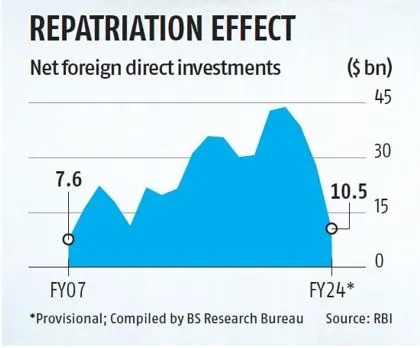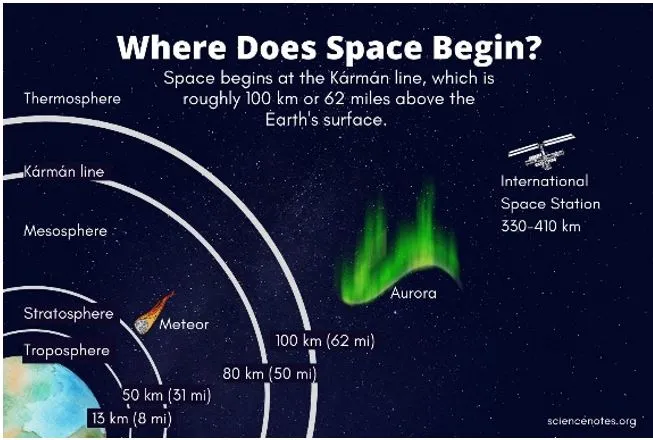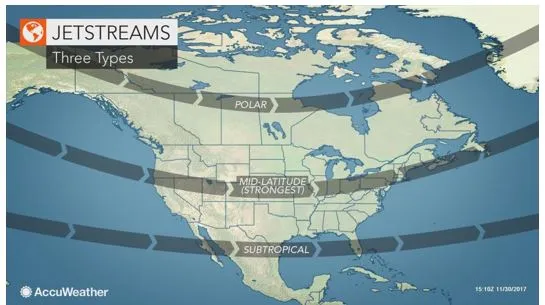

23rd May 2024 (15 Topics)
Mains Issues
Context
Ireland, Norway, and Spain have announced their formal recognition of Palestine as a state.
A Brief History of the Conflict (Background):
- Recognition of Palestine state is a long-standing issue between Israel and the Palestinians.
- Two-State Solution: In 1947, the United Nations proposed a partition plan for the creation of both a Jewish and Palestinian state. However, the Palestinians and the wider Arab world rejected it because it favored the Jewish population, leaving Palestinians with less land despite being the majority.
- Subsequent conflicts, particularly the Arab-Israeli war in 1948 and the Six-Day War in 1967, resulted in Israel gaining control over Palestinian territories.
- Current Situation: Decades of peace talks have failed to resolve the conflict, with the United States, Britain, and other Western countries supporting the idea of an independent Palestinian state alongside Israel.
What does this recognition signify?
- While Ireland, Norway, and Spain's recognition of Palestine won't immediately change the situation on the ground, it carries symbolic significance.
- It enhances Palestinians' international standing and increases pressure on Israel to engage in negotiations for peace.
- Who Recognizes Palestine? Nearly three-quarters of UN members recognize Palestine, primarily countries from West Asia, Africa, and Asia. However, major Western powers such as the United States, Canada, most of Western Europe, Australia, Japan, and South Korea do not.
- Palestine currently holds an enhanced observer status at the UN, allowing participation but not voting rights.
- It's also recognized by organizations like the Arab League and the Organisation of Islamic Cooperation.
Fact Box:Criteria for Recognition:
What is Palestine?
|


Mains Issues
Context
Foreign direct investment (FDI) in India has seen a significant downturn, prompting concerns about the country's economic health, as per RBI's "State of Economy".
Key-findings
- Overview of FDI Trends: Data from the Reserve Bank of India (RBI) reveals a sharp decline in FDI, with actual investments dropping to USD 26.6 billion in FY 2023-24, the lowest since 2006-07.
- Rising Repatriation and Disinvestment: Foreign companies have increasingly withdrawn investments from India, with repatriated or disinvested funds reaching USD 44.4 billion in FY 2023-24, the highest since 2011-12.
- Trends Over Time: The trend of declining FDI inflows and rising outflows has persisted for several years, indicating a sustained challenge for India's investment climate.
- Sectoral Distribution of FDI: Over 60% of FDI equity flows were directed towards specific sectors, including manufacturing, energy, and services.
- Contributors to FDI Inflows: Singapore, Mauritius, the US, and other countries have been major contributors to FDI inflows into India, as reported by the RBI.
- India's Global Standing: Despite challenges, India remains among the top 10 economies expected to experience high FDI momentum in 2024.
- Global Investment Patterns: A shift in global investment patterns, driven by factors like the COVID-19 pandemic, has seen FDI flows move from developed to developing economies.
- Prospects for Indian Companies: Indian companies have announced a significant number of greenfield FDI projects abroad, indicating their growing presence in the global market.
Role of FDI in promoting economic growth:
- Capital Inflow:FDI provides a source of external capital, which can be used for investment in various sectors of the host country's economy. This capital infusion can stimulate economic development.
- Technology Transfer:Multinational corporations that make FDI often bring advanced technologies, skills, and best practices to the host country. This technology transfer can lead to increased productivity and innovation in domestic industries.
- Job Creation:FDI projects often lead to the creation of jobs in the host country. This contributes to reduced unemployment and improved living standards.
- Increased Productivity:FDI can enhance the efficiency and productivity of domestic firms through knowledge sharing and collaboration with foreign investors.
- Infrastructure Development:In some cases, FDI projects require the development or improvement of infrastructure, which can have spillover effects on the broader economy.
- Export Promotion:FDI can facilitate access to global markets, as foreign investors often use their host country operations as export bases. This can boost a country's exports and improve its trade balance.
- Stimulated Local Businesses:Local businesses may benefit from FDI by becoming part of the supply chain or through other collaborative efforts with foreign companies.
- Government Revenues:FDI can lead to increased tax revenues for the host country, which can be allocated to public services and infrastructure development.
- Balanced Development:FDI can contribute to more balanced and diversified economic development by promoting investments in various sectors, including manufacturing, services, and technology.
PYQQ: Justify the need for FDI for the development of the Indian economy. Why is there a gap between MOUs signed and actual FDIs? Suggest remedial steps to be taken for increasing actual FDIs in India. (2016) |


Mains Issues
Context
The Reserve Bank of India (RBI) has approved the transfer of Rs 2.11 lakh crores (highest ever yearly surplus transfer to the government) as surplus to the government for the financial year 2023-24.
Major Factors responsible for sharp jump:
- The sharp jump in the surplus amount could be attributed to higher income from the forex holding of the central bank, among other factors.
- The higher-than-expected surplus would support the the centre's liquidity surplus, and, thereafter, expenditure.
About RBI’s surplus transfer
- The RBI gives its surplus money to the government, the owner of the institution every year after setting aside some for emergencies.
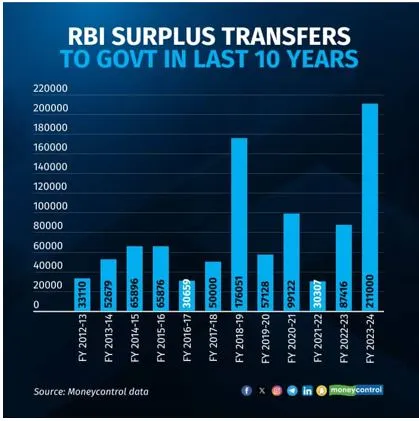
|
Generation of Surplus by RBI |
RBI's Expenditure |
|
|
Government's Use of Surplus:
- The government usually puts the surplus money into the Consolidated Fund of India.
- This fund is used for paying salaries, pensions, interest payments, and government programs.
- It helps the government reduce planned borrowings and keep interest rates low.
- Also provides opportunities for private companies to raise money from markets.
- Can help lower the fiscal deficit if revenue targets are met.
- Alternatively, the government can use the funds for public spending or specific projects to boost economic activity in certain sectors.
Fact Box: Calculation Method
|


Mains Issues
Context
Gopi Thotakura, an entrepreneur and pilot, became the first Indian space tourist on Blue Origin's NS-25 mission, led by Jeff Bezos. He's the first Indian citizen to experience space tourism, but officially the second Indian astronaut after Wing Commander Rakesh Sharma in 1984.
What is Space Travel?
- Space travel starts around 100 km above Earth's surface, crossing the Karman line, which marks the boundary between Earth's atmosphere and outer space.
- Anything flying below this line is considered an aircraft, while anything crossing it is a
Private Space Tourism:
- Private space tourism became active in 2021 with companies like Virgin Galactic, Blue Origin, and SpaceX offering missions.
- These missions opened space tourism to anyone willing to pay.
- Different missions require different levels of training. Sub-orbital flights, like Thotakura's, require minimal training usually included in the ticket price.
- Accessibility: Space tourism is currently only affordable for the super-rich.
- Some more affordable options, like high-altitude balloon rides, are emerging. These take passengers up to 100,000 feet for about $50,000. While they don't offer weightlessness, passengers can see the curvature of the Earth.
Fact Box: Kármán line
|


Prelims Articles
Context
Russia's defense ministry suggested changing the borders of its territorial waters in the Baltic Sea. Possible areas affected include eastern Gulf of Finland, islands near the Finnish coast, Baltiysk, and Zelenogradsk in Kaliningrad.
About Baltic Sea Region:
- The Baltic Sea is a large brackish inland sea bordered by several countries.
- It stretches from St Petersburg to Denmark, including Finland, Sweden, Estonia, Latvia, Lithuania, Poland, Germany, and Denmark.
- Notable subdivisions: Gulf of Bothnia in the north, Bothnian Sea, and Sea of Åland in the south.
- Geographical Features:
- Maximum depth: 459 meters, located on the Swedish side.
- Connections:
- Gulf of Finland connects to Saint Petersburg, Gulf of Riga between Estonia and Latvia.
- Artificial waterways connect the Baltic Sea to the White Sea and the North Sea.
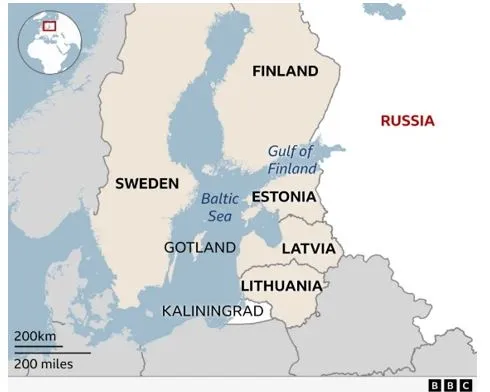


Prelims Articles
Context
A recent report from Oxford Economics has evaluated cities worldwide based on various factors like economic output and quality of life. Surprisingly, no Indian city made it into the top 300, with Delhi ranking the highest at 350.
Key Findings
- The report ranks cities across 163 countries on parameters like economics, human capital, quality of life, environment, and governance.
- New York topped the list, followed by London and San Jose.
- New Delhi ranked 51st in human capital, surpassing cities like Geneva and Canberra. However, Sultanpur in Uttar Pradesh scored poorly in multiple categories, ranking last overall.
- The index contains five categories: Economics, Human Capital, Quality of Life, Environment, and Governance, which are aggregated to create an overall score for each city.
- Economics is measured by GDP size and employment opportunities
- Quality of life considers life expectancy and housing costs
- Human capital assesses education and skills
- Environment looks at air quality and emissions intensity
- Governance measure political stability of a city and protection of residents’ rights
- Implications
- Global Impact: The 1,000 largest cities contribute significantly to global GDP and population.
- Regional Disparities: South Asian cities ranked lowest in most parameters, with North America leading in quality of life.
- Future Challenges: Migration, housing crises, and healthcare infrastructure could affect rankings. Climate change poses additional threats, impacting multiple categories due to rising temperatures and natural disasters.


Prelims Articles
Context
At the World Hydrogen Summit 2024 in Rotterdam, Netherlands, India highlighted its strategic vision and capabilities in the domain of renewable energy and green hydrogen production.
What is green hydrogen energy?
- Hydrogen, the simplest and most abundant element in the universe, holds immense potential as a clean energy source.
- Hydrogen is a clean alternative to methane, also known as natural gas.It's the most abundant chemical element, estimated to contribute 75% of the mass of the universe.
- When burned, hydrogen produces energy in the form of heat, with water as its only by-product. This process generates no carbon dioxide emissions, offering a promising solution to reduce carbon emissions and combat global warming.
- Green Hydrogen: Green hydrogen is produced via a method called electrolysis, a highly energy-intensive process that employs electricity to separate water molecules into their component parts (hydrogen and oxygen molecules).
Initiatives:
- Focus on non-fossil fuel: 43 per cent of India’s current installed electricity capacity is from non-fossil-fuel sources, with projections indicating a rise to 50 per cent by 2030.
- National Green Hydrogen Mission: It is a flagship initiative to foster the development and adoption of green hydrogen technologies in India. With a target of establishing 5 million tonnes of annual green hydrogen production capacity by 2030, the mission represents a significant step towards realising India’s ambitions in the hydrogen economy.
- Strategic Interventions for Green Hydrogen Transition (SIGHT) Programme.
- FDI: The renewable energy sector allows up to 100 percent FDI under the automatic route.
PYQQ: With reference to green hydrogen, consider the following statements: (2023)
How many of the above statements are correct?
Solution: (c) |


Prelims Articles
Context
A recent incident involving severe turbulence on a Singapore Airlines flight from London to Singapore has highlighted the dangers posed by clear-air turbulence (CAT) in air travel. As per a recent research, CAT is expected to intensify due to climate change.
Understanding Clear-Air Turbulence:
- Turbulence on flights is caused by storms, mountains and strong wind currents called jet streams.
- Clear-air turbulence occurs unexpectedly and violently buffets planes even in cloudless skies. Unlike turbulence caused by storms or mountains, CAT is not easily detectable, making it particularly hazardous for aircraft.
- Regions over western ocean basins, particularly in winter, are most susceptible to CAT due to large zonal temperature contrasts between the ocean and land. These temperature gradients create vertical wind shear, further exacerbating turbulence.
Role of Climate Change:
- Over the past four decades, CAT incidents have become more frequent, mirroring the trend of climate change.
- Rising carbon dioxide emissions lead to warmer air, which increases wind shear within jet streams, thereby strengthening CAT globally.
Fact Box: What's a Jet Stream?
|
PYQQ. Consider the following statements: (2020)
Which of the statements given above is/are correct:
Solution: (c) |


Prelims Articles
Context
About half of the world’s rangelands are degraded and need policy interventions, and communities depending on them need focused support, according to a new report of the United Nations Convention on Combating Desertification (UNCCD).
What are Rangelands?
- Rangelands are natural or semi-natural areas where animals like livestock graze.
- They contain vegetation like grass, shrubs, and trees, influenced by climate factors like rainfall and temperature.
- Rangelands cover over half of the Earth's land and are important for food, water, and preventing
- Importance of Rangelands:
- They act as carbon sinks, store freshwater, and support millions of people for food and livelihoods.
- They produce 16% of global food and 70% of feed for animals, especially in Africa and South America.
- In India, rangelands span from the Thar Desert to Himalayan meadows.
- Rangelands are vital ecosystems for grazing animals, and pastoralists, who depend on these lands, contribute significantly to India's livestock and dairy industries.
- Impact of climate change:
- Nearly 50% of the world’s rangelands can be considered “degraded” and are facing a “silent demise”.
- Primary drivers of degradation: Climate change, unsustainable land and livestock management practices, biodiversity loss, and the conversion of rangelands to farmlands. Uncertainty over land rights among pastoralist communities also leads to their degradation.
Fact Box: About Pastoralists
|


Prelims Articles
Context
A rare hemi-parasitic terrestrial plant has been found in Phawngpui National Park of Mizoram.
Key-highlights
- Named Phtheirospermum lushaiorum, this new species was published in the esteemed plant taxonomy journal,
- Phtheirospermum lushaiorum is a hemi-parasitic plant, meaning it lacks a fully developed root system and obtains water and minerals from another plant.
- However, it still possesses chlorophyll and can produce its own food through
- Specialized structures called haustoria allow it to tap into the host plant's sap-conducting tissue.
- The plant flowers from July to September and bears fruits from August to October.
- The specific epithet "lushaiorum" honors the Lushai tribe of Mizoram, reflecting their dedication to biodiversity conservation.
Fact Box: About Lushai Tribe
|


Prelims Articles
Context
Researchers from the Zoological Survey of India rediscovered the Sri Lankan golden-backed frog (Hylarana gracilis) in the Koundinya Wildlife Sanctuary, Chittoor district. This marks its reappearance after two centuries, adding to India's freshwater frog species count, now totalling 20.
About Sri Lankan Golden-Backed Frog
- Sri Lankan golden-backed frog (Indosylvirana serendipi), is a species of frogin the family Ranidae.
- These frogs are typically found in tropical lowland evergreen forests, along stream banks, and in marshy areas.
- They are native to Sri Lanka but have been newly recorded in the Eastern Ghats.
- Significance: The rediscovery highlights the historic land bridge between India and Sri Lanka. Amphibians like these frogs serve as ecological indicators, and the Eastern Ghats, where they were found, host 27 amphibian species, fewer than the Western Ghats.
Fact Box: Koundinya Wildlife Sanctuary
|


Prelims Articles
|
S.No. |
Term |
About |
|
1. |
Contingent Risk Buffer (CRB) |
CRB refers to the risk provisioning made from economic capital to cover monetary, fiscal stability, credit and operation risks. |
|
2. |
Desertification |
Desertification is the persistent degradation of dryland ecosystems by variations in climate and human activities. |
|
3. |
Open market operations (OMOs) |
They are one of the tools used by central banks to influence and manage the money supply and interest rates in an economy. |
|
4. |
Rangeland |
Rangeland is any extensive area of land that is occupied by native herbaceous or shrubby vegetation which is grazed by domestic or wild herbivore |
|
5. |
Sub-orbital flights |
Sub-orbital flights are space flights that go up into space for a short period of time but do not complete a full orbit around the Earth. Instead, they reach a high altitude above the Earth's surface, typically crossing the boundary of space, called the Karman line, which is around 100 kilometers above the Earth. |


Editorials
Context
The recent summit between Russian President Vladimir Putin and Chinese President Xi Jinping in Beijing, marking the 75th anniversary of bilateral diplomatic relations, highlights the deepening ties between Russia and China. This relationship, characterized as having "no limits," has significant implications for global geopolitics, especially for countries like India.
The Phases of Russia-China Ties
- Historical Context: Over the past two centuries, Russia-China relations have gone through several phases. The 19th century saw Czarist Russia expanding into a weakened China, a trend that continued into the Soviet era.
- Ideological Shifts: After the establishment of the People's Republic of China (PRC) in 1949, a brief period of “Comintern brotherhood” was disrupted by ideological and geopolitical differences, such as the Sino-Soviet split in the 1960s.
- Modern Realignments: The current phase began in 2012 with increased U.S.-China tensions leading to closer Russia-China ties. The 2022 Beijing Summit declared their relationship to have “no limits,” further solidified by Russia's dependence on China following Western sanctions over the Ukraine conflict.
Joint Statement and Strategic Implications
- Economic and Military Silence: The joint statement from the recent summit was notably silent on specific economic, financial, and military ties, possibly to avoid further Western sanctions or to mask internal disagreements.
- Anti-U.S. Stance: The statement strongly criticized U.S. policies, accusing it of pursuing “dual containment” of Russia and China, which they view as hostile and destabilizing.
- Future Cooperation: In the short term, the summit is likely to lead to intensified bilateral cooperation, especially in areas critical to Russia's military efforts in Ukraine. In the long term, this could result in deeper economic and technological collaboration, potentially challenging the U.S.-led global order.
Impact on India
- Strategic Concerns: India's relationship with Russia, especially in defense, could be affected by Russia's increasing dependence on China. This raises concerns about the reliability of Russian defense supplies amidst India's border tensions with China.
- Global Positioning: India must evaluate the evolving Russia-China dynamic critically, considering its implications for India's strategic autonomy and global aspirations.
- New Opportunities: As global polarizations emerge, India should leverage its strategic autonomy, focusing on its core national interests and pursuing a balanced approach to maintain its global standing.
UPSC Mains Questions
Q. Analyze the implications of the evolving Russia-China relationship on India’s strategic interests and defense procurement. How can India balance its strategic autonomy with emerging global polarizations?


Editorials
Context
The inflationary trends in India, particularly influenced by the prices of vegetables like tomato, onion, and potato (TOP), have significant implications for the economy. These commodities, despite their relatively small weight in the Consumer Price Index (CPI), play a critical role in shaping inflation trends due to their price volatility.
The Impact of TOP on Inflation
- Significance of TOP in CPI: Within the CPI basket, vegetables hold a weight of 6.04%, with TOP accounting for 2.2%. These commodities have historically influenced food and beverage inflation as well as headline CPI figures.
- Price Surge and Contribution to Inflation: In FY2023-24, vegetable prices soared by about 15% year-on-year. For instance, tomato prices increased by 202% in July 2023, contributing to 18.1% of the total headline inflation, despite tomatoes holding only a 0.6% weight in the CPI basket.
- Urban vs. Rural Impact: TOP's significance varies across demographics, constituting 3.6% of the urban consumption basket and 5% in rural areas for the bottom 5% consumption class, reflecting a substantial impact on inflation for different population segments.
Price Volatility and Its Implications
- Volatility Metrics: The coefficient of variation (CoV) for TOP inflation is 5.2, significantly higher than the vegetables sub-group (CoV=3.0), the food group (CoV=0.6), and headline inflation (CoV=0.3). This indicates a high sensitivity to market dynamics, weather fluctuations, and supply chain issues.
- Inflation Trends: The inflation rate for the TOP sub-group has shown extreme volatility, ranging from -36.6% in September 2021 to 132.0% in December 2019, underscoring the unpredictable nature of these commodities.
- Impact on Farmers: The volatility in TOP prices affects farmers adversely as they do not benefit from Minimum Support Price (MSP) and often sell to private traders. This market instability can result in significant income fluctuations for farmers.
Policy Recommendations and Farmer Support
- Overhauling Agricultural Value Chains: Improving cold storage facilities, streamlining agricultural value chains, and reducing input costs for fertilizers and pesticides can help stabilize prices and benefit farmers.
- Policy Interventions: There is a need for long-term measures rather than short-term fixes like abrupt export bans. Policies should focus on sustainable solutions that address the root causes of price volatility.
- Minimum Support Price (MSP) for TOP: Farmers have consistently demanded MSP for onion and other TOP crops to ensure stable incomes. Recognizing and addressing these demands through policy adjustments can provide much-needed support to the agricultural sector.
UPSC Mains Questions
Q. Evaluate the role of the Consumer Price Index (CPI) in reflecting the cost of living in India. What policy measures can be adopted to mitigate this volatility?


Editorials
Context
The phenomenon of declining voter numbers in the 2024 elections, despite the general trend of increasing voter participation in India, raises significant questions about the underlying causes and implications for the electoral process.
Analysis of Voter Decline
- Unexpected Decline in Voter Numbers: Contrary to the expectation that voter numbers increase every election cycle due to population growth, nearly one-third of constituencies in the 2024 elections witnessed a decline in the absolute number of voters compared to 2019.
- Statistical Insights: Analysis up to Phase 5 of the 2024 elections revealed that out of 427 constituencies, 115 (27%) saw fewer voters than in 2019. This is an unprecedented trend in India's electoral history, especially since such declines were minimal or non-existent in previous elections.
- Overall Voter Numbers: While over 505 million people voted in 2024 compared to 485 million in 2019, marking a 4% increase, this is significantly lower than the 12% increase observed between 2014 and 2019, highlighting a concerning slowdown in voter growth.
Potential Causes of Decline
- Geographic Concentration: The majority of constituencies with declining voter numbers are located in six states: Kerala, Madhya Pradesh, Rajasthan, Tamil Nadu, Maharashtra, and Uttar Pradesh.
- Factors Influencing Voter Turnout: The decline could result from fewer new eligible voters, increased emigration, or lower voter turnout. Given the continuous population growth, a significant drop in new eligible voters is unlikely, and widespread emigration is not plausible in the affected constituencies.
- Turnout Patterns: The most likely explanation is a sharp decline in voter turnout. This drop raises questions about voluntary abstention versus potential voter suppression or coercion.
Implications and Further Questions
- Impact on Opposition: The decline in voter numbers appears more pronounced in constituencies where the Opposition had won in 2019 or was expected to perform well in 2024, suggesting potential political undercurrents affecting voter behavior.
- Phased Election Analysis: The trend of declining voter numbers fluctuated across different phases of the elections, indicating no consistent pattern of voter apathy or engagement throughout the election process.
- Need for Investigation: This unusual trend necessitates a thorough investigation by the Election Commission to understand the underlying reasons and to ensure the integrity and inclusivity of the electoral process.
UPSC Mains Questions
Q. Analyze the implications of declining voter numbers in key constituencies on the democratic process in India. How does this trend affect political representation and voter confidence in the electoral system?



